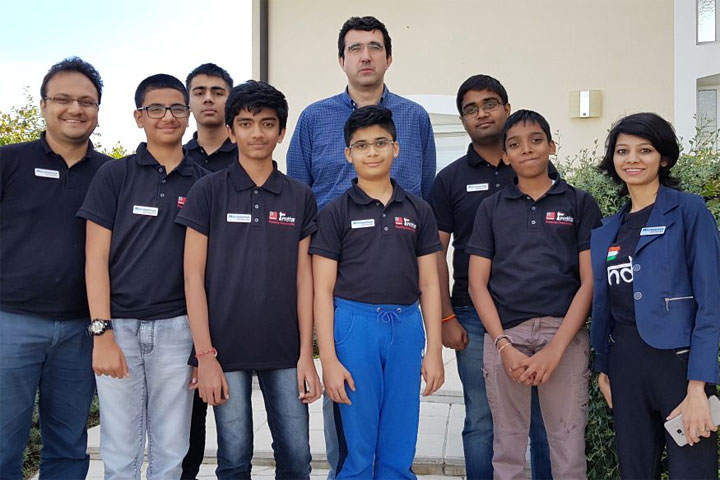


On this DVD Vladimir Kramnik retraces his career from talented schoolboy to World Champion in 2006. With humour and charm he describes his first successes, what it meant to be part of the Russian Gold Medal team at the Olympiad, and how he undertook the Herculean task of beating his former mentor and teacher Garry Kasparov.
On the second day of the Kramnik Microsense Chess India Program, it was mostly about endgames. But before the day began Vlad gave the class a problem to solve. We ask you to solve it as well — it is quite breath-taking.
Gukesh was going to the washroom to get ready for the day. I asked him to come and have a look at the this position, which Kramnik had sent via WhatsApp a few minutes ago. Just as a warm up for the day. He wanted the youngsters to crack this one before he arrived. Gukesh looked at the position for around 30 seconds and then went on for his shower.
I assumed Gukesh had forgotten about the position, and when he turned up at the breakfast table, with his new t-shirt and looking fresh, I asked him to join us in solving the position. "I found the solution", he exclaimed. But when? "While getting ready!" Gukesh had memorized the position and was thinking about it in his head under the shower!
So what's the answer? 1.♕f1! said Gukesh (you can move the pieces on the diagram above to follow the solution). And suddenly it became clear to everyone what the idea was! Isn't it beautiful? If Black takes 1...♚xe6 and White mates with...? Yes, you got that right! 2.♕f5#!! That is a square that is attacked three times, but all the attacking pieces are suddenly pinned. And if Black tries to defend by moving the knight, 2.♕f6 mates; if he moves the rook it is 2.♕f4#; and if he moves the queen it is mate by rook or queen on the e-file. What a pretty position!
Vladimir usually arrives at around 10.30 a.m. for his training session. What happens between the time these boys wake up and Kramnik arrives is amazing! They are all in some kind of a trance, not because they are sleepy but all of them have been spending time thinking about a chess position. Praggnanandhaa has refuted some analysis from the previous night, Leon is waking up Iniyan and Raunak to tell them that White is no longer winning in a variation that they thought he was, Prithu is going to the washroom when he suddenly sees that two of his friends are analyzing. He joins them and sits there for the next thirty minutes! The Champions House is brimming with chess, and the reason is pretty simple: everyone simply loves the game here! Chess is the most important thing in their lives!
Endgames of the World Champions from Fischer to Carlsen
Let endgame expert Dr Karsten Müller show and explain the finesses of the world champions. Although they had different styles each and every one of them played the endgame exceptionally well, so take the opportunity to enjoy and learn from some of the best endgames in the history of chess.
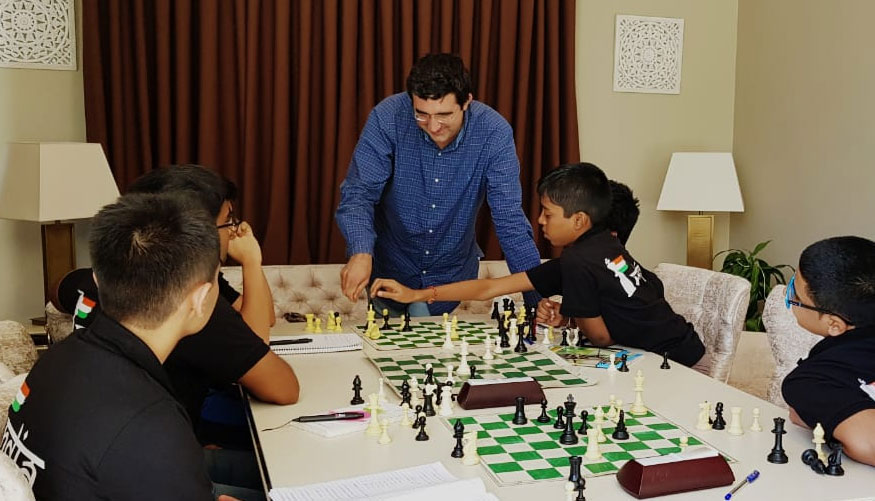
Click or tap any picture to enlarge
On the second day Kramnik showed ten of his games in which he had beaten some of the best players in the world from slightly better endgame positions. The trick was always to keep improving his pieces, and at the right moment strike with accurate calculations. While this is easy to speak about, it is extremely difficult to execute in practical play. That's what makes Kramnik one of the greatest endgame players alive! In the camp he is training the kids on how they can imbibe some of his endgame skills. Here's an example:

[Event "Corus"] [Site "Wijk aan Zee"] [Date "2000.01.15"] [Round "1"] [White "Kramnik, Vladimir"] [Black "Adams, Michael"] [Result "1-0"] [ECO "E15"] [WhiteElo "2758"] [BlackElo "2715"] [SetUp "1"] [FEN "2q3k1/p3bppp/1p3n2/3p4/3B4/1P1P2PP/PQ3PB1/6K1 b - - 0 26"] [PlyCount "46"] [EventDate "2000.01.15"] [EventType "tourn"] [EventRounds "13"] [EventCountry "NED"] [EventCategory "18"] [SourceTitle "CBM 075"] [Source "ChessBase"] [SourceDate "2000.04.05"] [SourceVersion "1"] [SourceVersionDate "2000.04.05"] [SourceQuality "1"] {To excange queens on c3 or not? These are the types of difficult questions you need to solve if you want to become an endgame expert. And somehow there is no right or wrong answer. How do you decide what is good or not? This is where the experience of Kramnik comes into the picture. According to him, White hasn't really reached the stage in this endgame where he should be exchanging the queens. He still needs to improve his position and keep the option open with regards to exchange. And that's the reason why 27.b4! was played. One may argue that 27.Qc3 was also good, and Kramnik himself is quite cautious in putting down a move as bad, but when you see how the game progressed you will realize that keeping the queens was definitely a much better decision.} 26... h6 27. b4 Qe6 28. Qc3 Ne8 29. a4 Bf6 30. Kh2 Qd7 31. a5 Kh7 32. Bxf6 Nxf6 33. Qe5 Qd8 34. a6 Kg8 35. d4 b5 36. Bf3 Kf8 37. Kg2 Kg8 38. h4 Qb6 39. Bxd5 Nxd5 40. Qxd5 Qxa6 41. Qd7 Qg6 42. Qe8+ Kh7 43. d5 a5 44. bxa5 b4 45. d6 b3 46. d7 Qc6+ 47. Kh2 Qf3 48. Qe1 Qd3 49. a6 1-0
So that's how your intuition develops! Kramnik also makes an important point — if you remove the pawns on d3 and d5, then the queen exchange makes complete sense, because the board is much more open and the chances of reaching an opposite couloured bishop endgame are much less. So there you see, that's one difficult decision to think about. Imagine a day where you have 50 such decisions to make, and each time you do it, you get feedback from Kramnik. This is definitely going to help these super-talents to improve — dramatically!
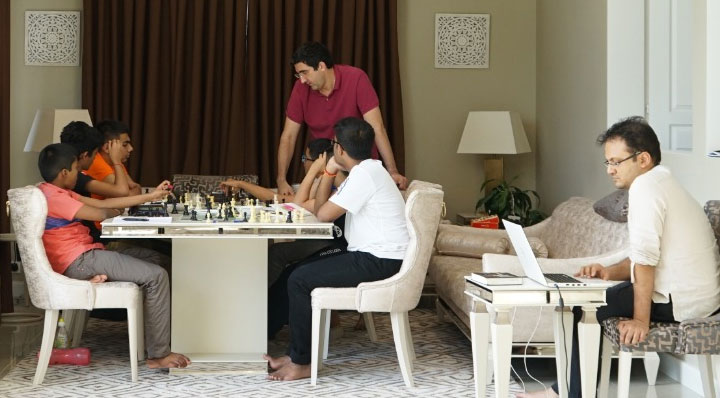
The setup of the camp

Here's a second example of the work Vlad is doing with the kids. If you spend some time looking at my notes you can learn a bit, together with the super-talents:

[Event "Qatar Masters op"] [Site "Doha"] [Date "2014.12.03"] [Round "8"] [White "Salem, AR Saleh"] [Black "Kramnik, Vladimir"] [Result "0-1"] [ECO "D63"] [WhiteElo "2586"] [BlackElo "2760"] [Annotator "Sagar Shah"] [PlyCount "110"] [EventDate "2014.11.26"] [EventType "swiss"] [EventRounds "9"] [EventCountry "QAT"] [SourceTitle "CBM 164"] [Source "ChessBase"] [SourceDate "2015.01.15"] [SourceVersion "1"] [SourceVersionDate "2015.01.15"] [SourceQuality "1"] 1. d4 Nf6 2. c4 e6 3. Nf3 d5 4. Nc3 Nbd7 {This is a small tweak in the opening. Main moves are of course Be7 which leads to the QGD and Bb4 which leads to the Ragozin. With this move Nbd7, Black keeps the game in QGD territory but gets some additional options.} 5. Bg5 (5. Bf4 c6 6. e3 Nh5 {Though only tried in blitz by Carlsen and Kramnik, it could be possible that Kramnik was intending to play this today and that is the reason why he chose 4...Nbd7 move order.}) 5... h6 6. Bh4 Be7 7. e3 O-O 8. Rc1 c5 9. cxd5 Nxd5 (9... exd5 10. Bd3 $14 { is a definite edge for White from the opening.}) 10. Bxe7 Nxe7 {White should be slightly better here. Black has played the opening quite unambitiously. But White's advantage is not very threatening as Kramnik proves over the next few moves.} 11. Be2 {The bishop looks much better placed on e2 than on d3.} (11. Bd3 b6 12. O-O Bb7 13. Qe2 (13. e4 cxd4 14. Nxd4 Ng6 $15) 13... Bxf3 $1 14. Qxf3 cxd4 15. exd4 Nf6 $11 {In this IQP position where two pairs of minor pieces have been exchanged and also the d5-square is under the control of the knights, Black shouldn't be worse.}) 11... b6 12. O-O Bb7 13. dxc5 Nxc5 14. Nd4 (14. Qxd8 Rfxd8 15. Rfd1 Nd5 (15... Rac8 16. Nb5 Rxd1+ 17. Rxd1 Bd5 $11) 16. Nxd5 Bxd5 17. b3 $11 {and in this symmetrical position I wonder how Kramnik would have won. But I am nowhere near Kramnik's technique so it's better that I do not get into it! The position however looks completely drawish.}) 14... Nf5 $5 15. Nxf5 exf5 {Why would Kramnik voluntarily double his pawns? Maybe he just wanted to unbalance the position in some way or the other, no matter how little.} 16. Bf3 $6 {I dislike this move. It might be objectively fine but if White wanted to play safely then why not just exchange the queens and play Rfd1?} (16. Qxd8 Rfxd8 17. Rfd1 $11) 16... Qxd1 17. Rfxd1 Bxf3 18. gxf3 Rfd8 19. Kf1 {Bringing the king into the centre is natural.} (19. Rxd8+ Rxd8 20. Rd1 Rxd1+ 21. Nxd1 {This position might not hold any advantage for Black but it is a very timid decision of trying to exchange both the rooks and bringing your knight to an unfavourable square. Something that Salem Saleh being an aggressive player would dislike. Also White has no reasons to resort to such exchanging operations.}) 19... g6 20. Ke2 Kg7 21. Nb5 Kf6 22. Rxd8 Rxd8 23. b4 (23. Nxa7 {I like this variation because it is quite unusual.} Ra8 24. Nc8 $5 { This is the surprising move.} Rxa2 (24... Rxc8 25. b4 Ra8 (25... Ke5 26. bxc5 bxc5 27. a4 Kd5 28. Kd3 Ra8 29. Ra1 Ra5 30. Kc3 h5 31. h4 $11) 26. bxc5 Rxa2+ 27. Kf1 bxc5 28. Rxc5 $11 {and even the best technique in the world cannot win this.}) 25. Rc2 Ra6 (25... Na4 26. Kd2 Ra1 27. b3 Nc5 28. b4 Nd7 29. f4 Rh1 30. Rc7 $14) 26. Nxb6 Rxb6 27. Rxc5 $11) 23... Ne6 24. Rc6 (24. Nc7 Rd7 (24... Rc8 25. Nd5+ $18) 25. Nxe6 fxe6 $11) 24... Ke7 25. a3 Rd7 26. Rc8 a6 27. Nc3 b5 28. Ra8 Rd6 29. Rh8 (29. Nb1 {with the idea of placing the knight on b3 via d2 is a good idea. It would tie up the knight on e6.} Kf6 30. Nd2 Kg5 31. f4+ Kh4 32. Nf3+ Kh3 33. Ne5 {And it is White who is creating some dangerous play.}) 29... g5 $1 (29... h5 {was also possible but the move g5 has a very deep idea behind it. Kramnik wants to keep the h5-square free for his king which would embark on a journey to attack the h2-pawn.}) (29... Rc6 $5 30. Kd3 Ng5 31. f4 Nh3 32. f3 Nf2+ 33. Kd2 Rd6+ 34. Ke2 Nd3 $36 {Black has an edge.}) 30. Ra8 (30. Rxh6 $2 Nf4+ $19) 30... Kf6 $1 {Kramnik now starts a king march towards the weakest point in White's camp. Any guesses? Of course the h2-pawn!} 31. Ra7 Kg6 32. Na2 Nd8 33. Ke1 $2 {Why waste time? It would have been better to execute the manoeuvre of putting the N on c5 via Nc1-b3-c5.} Kh5 {As Lasker said, "It is better to follow out a plan consistently even if it isn't the best one than to play without a plan at all". Here Black has a clear-cut plan of attacking the h2-pawn while White is doing nothing much. That is the main reason why his position slowly goes downhill.} 34. Nc1 Kh4 35. Nb3 Kh3 {Doesn't this king route remind you of the game Cohn-Rubinstein that was played in St.Petersburg in 1909 where the God of endgame play marched his king to the h3-square in a pure pawn endgame to attack the weak pawn on h2. It could be possible that Kramnik was motivated to find this idea from that game of Rubinstein.} 36. Nd4 (36. Nc5 Kxh2 37. Rxa6 Rxa6 38. Nxa6 Kg2 $19 {The h-pawn queens easily.}) 36... f4 37. Ra8 (37. Nf5 {also doesn't really help.} Rf6 38. e4 (38. Nd4 Kxh2 { is also possible.}) 38... Kg2 39. Ra8 Nc6 40. Rxa6 Re6 41. a4 (41. Ke2 Nd4+ $19 ) 41... bxa4 42. Rxa4 (42. b5 Ne5 43. Rxe6 fxe6 44. Nd4 a3 45. Ke2 a2 46. Nc2 ( 46. Nb3 Nxf3 47. b6 Nd4+ $19) 46... Nxf3 $19) 42... Ne5 43. Ke2 Nxf3 $19) 37... Kxh2 38. Nf5 Rf6 39. e4 (39. Nxh6 Rxh6 40. Rxd8 Kg2 {is a scary position, particularly because Ke2 doesn't work here.} 41. Ke2 $2 (41. Rg8 $1 {would lead most probably to a draw.} Kxf3 42. Rxg5 fxe3 43. Rf5+ Ke4 44. Rxf7 exf2+ 45. Kxf2 Rh3 46. Ke2 Rxa3 47. Kd2 $11) 41... g4 $1 42. fxg4 f3+ $19) 39... Nc6 40. Rxa6 Rg6 {You can bank on the fact that in this technical phase of the game, Kramnik will be the most accurate.} 41. Kf1 {Trying to lock the king in on h2.} Ne5 42. Ra5 (42. Rxg6 fxg6 43. Nd4 h5 44. Nxb5 g4 45. fxg4 hxg4 $19) 42... Nxf3 43. Rxb5 {It is a race between the pawns now but Black's pawns supported by the king are way faster than the white pawns. Also there will be mating nets being formed around the white king.} g4 (43... h5 {was the more accurate way to start.} 44. a4 h4 45. a5 h3 46. Rb6 Nd2+ 47. Ke2 Kg2 $19) ( 43... Nd2+ 44. Ke2 Nxe4 45. Re5 {gives White unnecessary counterplay.}) 44. Rd5 (44. a4 Rc6 $1 (44... g3 45. Nxg3 $1 Nd2+ 46. Ke2 fxg3 47. fxg3 Nxe4 48. Kf3 Nxg3 49. Rc5 $17 {White has some drawing chances because the black forces are not co-ordinated.}) 45. Rc5 Rxc5 46. bxc5 g3 47. fxg3 fxg3 48. Nxg3 Kxg3 49. c6 Nd2+ 50. Ke2 Nxe4 51. c7 Nd6 52. a5 h5 53. a6 Nc8 $19) 44... h5 45. Ng3 h4 ( 45... fxg3 46. Rxh5+ Nh4 47. Rxh4# {would be horrible!}) 46. Ne2 g3 47. fxg3 ( 47. Nxf4 g2+ 48. Nxg2 Rxg2 $19) 47... fxg3 {Now it is just winning for Black.} 48. b5 Rf6 49. Rf5 Rxf5 50. exf5 g2+ 51. Kf2 Nd4 52. Ng1 Nxb5 53. a4 Nc3 54. Nf3+ (54. a5 Ne4+ $19) 54... Kh1 55. a5 h3 (55... h3 56. a6 h2 $19 {A nice technical achievement by Kramnik. The thing that was impressive about this game was that even though Vladimir was in a must win situation and he was facing an opponent who was rated 200 points below him, he wasn't afraid to go into equal positions. He found those little imbalances like the h2-pawn weakness which would help him to put pressure on the opponent. Using all his technical superiority he ground out a win!}) 0-1
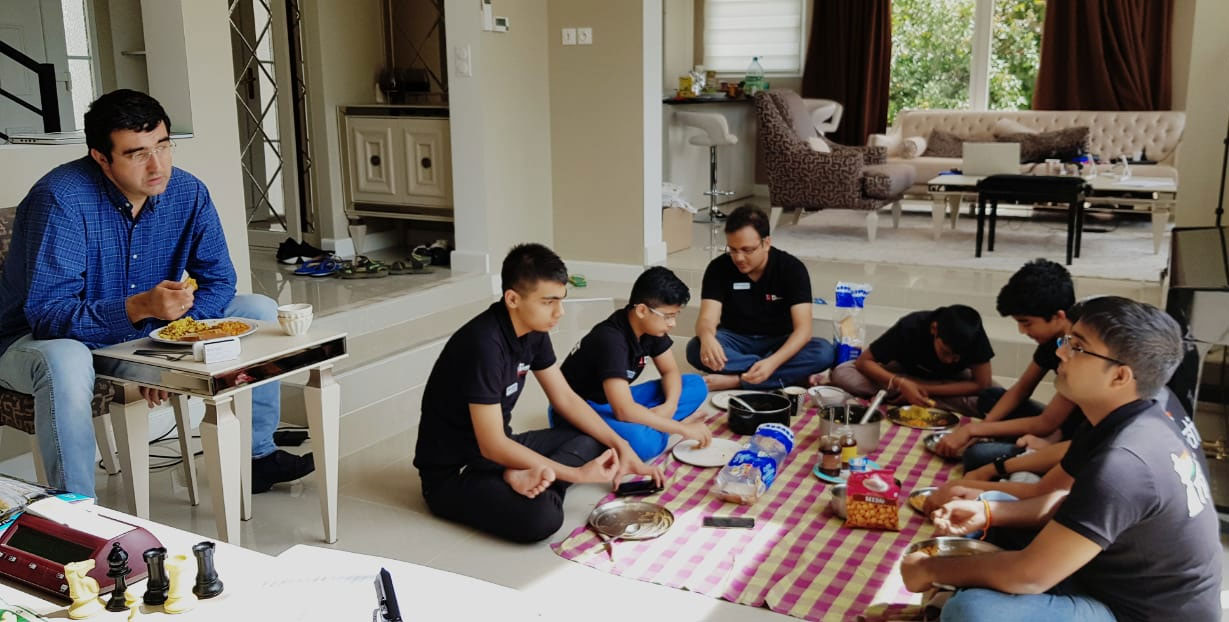
Food for thought — even during mealtimes chess is always in the discussion
 Teamwork: everyone goes out into the village to buy groceries
Teamwork: everyone goes out into the village to buy groceries

The beautifully calm rural ambiance of the Kramnik Camp

How they spend their evenings together — NB: the book is Dvoretsky's Endgame Manual.
One evening we did a Skype video conference call with Frederic Friedel in Hamburg. Fred has a lot of experience with young chess talents — we are talking Nigel Short, Garry Kasparov, Vishy Anand, Vladimir Kramnik, Peter Leko, the Polgar sisters, Magnus Carlsen and many others. His urgent advice to these youngsters: "When analysing with Kramnik you will find he says many things you immediately understand, but also things that are slightly mysterious. Listen especially carefully to those parts. He is thinking in categories that you don't know. Try to understand them and make them your way of thinking."
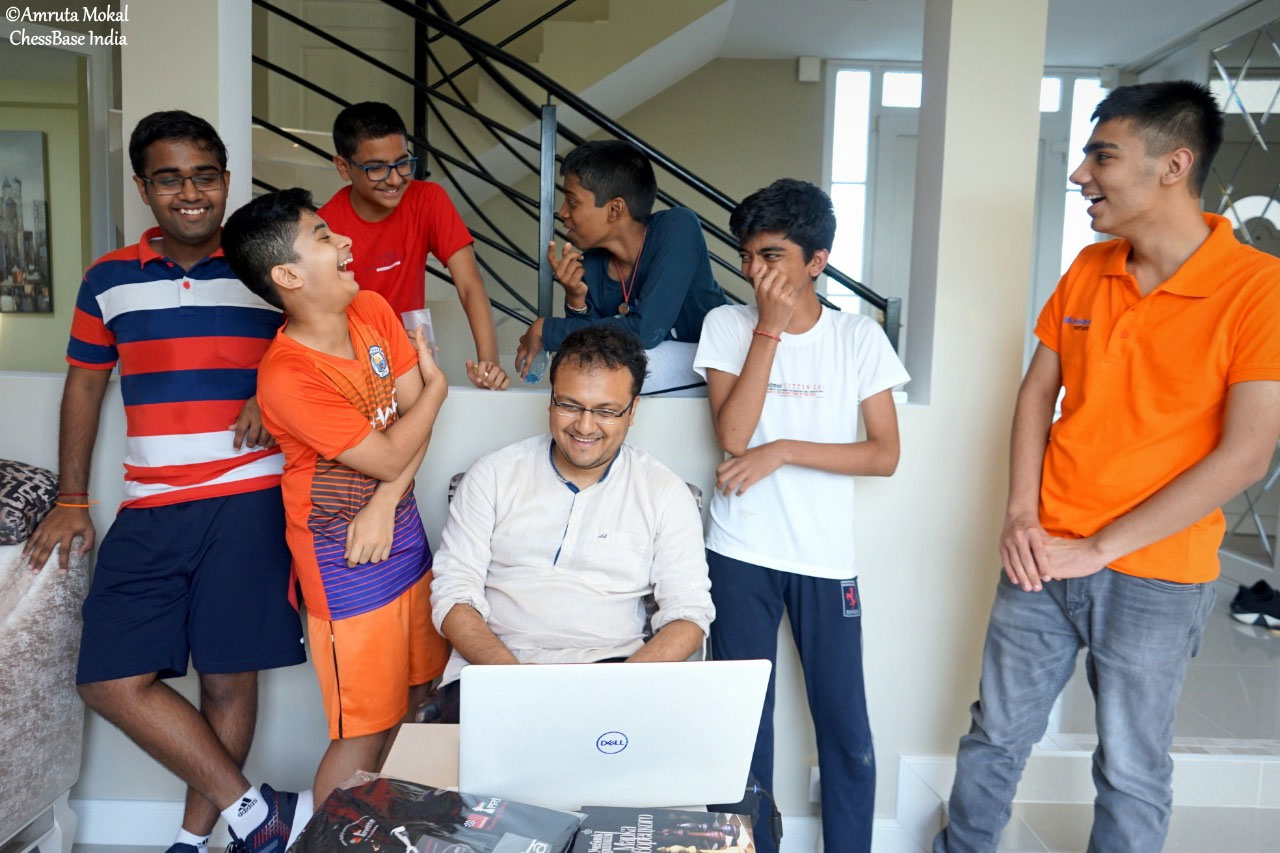
Of course, as is always the case with Fred, there was a lot of jesting and laughter. At one stage he gave them a puzzle: "I once played a game in which I mated my opponent with 6.gxf8=♘#. But I cannot remember the moves that led to that. Can you help me find them?"
Pragg immediately looked at Gukesh, saying: "Didn't you show me this problem?" Indeed he had, after Frederic had given it to him during his visit in Hamburg, three months earlier. But he and Pragg had not found the solution — unlike their 12-year-old friend Savithashri, who worked it out in one somewhat sleepless night.
Anyway, all six super-talents at the Kramnik Camp got to work. Raunak Sadhwani tried very hard for a couple of hours, but was only able to construct a mate in seven. The nice thing about this problem is that you cannot use an engine nor can you find the answer on Google. So once you don't get it, either you give it up or keep trying!
The next morning Praggnanandhaa stood at the breakfast table as in a trance. I asked him to have his breakfast, but he didn't seem to be interested. After around ten minutes he suddenly shouted out loud: "I have got it!" And yes, he had! It is a fun problem, and you can try moving the pieces on this board to solve it:
Master Class Vol.11: Vladimir Kramnik
This DVD allows you to learn from the example of one of the best players in the history of chess and from the explanations of the authors (Pelletier, Marin, Müller and Reeh) how to successfully organise your games strategically, consequently how to keep y